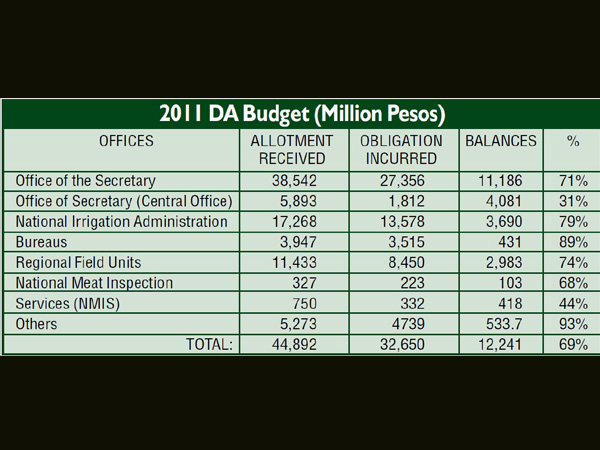Agriculture progress, PPP and the mayors
After growing by 2.6 percent last year, the agriculture sector grew by 1 percent and 0.7 percent, respectively, in the first and second quarters of this year.
We believe that with better DA budget utilization through Public-Private Partnership (PPP), agriculture progress can be significantly increased.
Highlighted in the table are the areas that show low budget utilization.

1. Cordillera Administrative Region (CAR)-47 percent
2. Region XII (SOCCSKSARGEN)-67 percent
Article continues after this advertisement3. Region XIII (CARAGA)-68 percent.
Article continues after this advertisementWe believe PPP in the monitoring and implementation of the DA budget will significantly improve the low utilization rate.
This should be done especially in the areas and regions previously identified.
DA budget
The DA budget increased significantly from P34.8 billion in 2011 to P52.9 billion in 2012. For 2013, the budget proposal for DA is P63.1 billion. If we include DA-attached agencies (e.g., NFA, PCA and PhilRice) and other projects under DA control, the total DA budget will be P72.9 billion.
Given slow agricultural growth but fast increase in the DA budget, budget utilization must be maximized.
We do not wish the 2011 experience of not utilizing more than P10 billion in the DA budget repeated in 2013.
Analysis
PPP for DA budget utilization should be harnessed through the legally mandated government-private sector Municipal Agriculture and Fishery Councils (MAFCs).
Most of them are not involved in the DA budget process.
DA should immediately allocate a significant amount of time and resources to change the mindset of the MAFCs so that they will feel responsible for helping DA budget utilization at the grassroots level.
It is argued that the major reason we have fallen behind our neighbors in agricultural development is because our agriculture extensive workers have been devolved to the local government units (LGUs).
Since DA no longer has control over them, they are often misused by unenlightened mayors for non-agriculture purposes.
Since the DA has offices only at the regional levels, it has difficulty in influencing what goes on in the municipalities.
This is where the MAFCs come in. They can help monitor and implement DA budget use. Furthermore, since they are attached to the DA, they can keep the DA regional offices informed of municipal agriculture activities (or non-activities).
DA can then allocate its agricultural resources to the municipalities based on each municipality’s performance.
In the past, DA gave little attention to the MAFCs. But with Agriculture Secretary Proceso Alcala’s commendable attention given to the rural areas, this transformation can come very quickly.
New DILG Secretary
The management expertise of Secretary Mar Roxas, who may soon head the DILG, can help complete the unfinished vision of Secretary Jesse Robredo.
This is for LGUs to be the champions of agricultural development.
With Roxas’ leadership, the mayors can internalize the role given to them by the Local Government Code: It is the mayor, not the DA, who is primarily responsible for agricultural growth in his or her municipality.
In turn, the MAFCs can help the mayors through their active participation in helping monitor and implement the DA budget.
At the head office, we recommend a MOA among the DA, DILG and the National Agriculture and Fishery Council (NAFC) to promote PPP at the local levels through the MAFCs. This way, with better DA budget utilization through PPP, significant agriculture progress can be achieved.
(The author is chairman of Agriwatch, former secretary for presidential flagship programs and projects, and former undersecretary for Agriculture, and Trade and Industry. For inquiries and suggestions, e-mail [email protected] or telefax (02) 8522112.)